The Gunung Mulu National Park is a Unesco World Heritage Site in the north of Sarawak, Borneo. The tropical rainforest covers many Borneo National Parks, and they’re home to a wide variety of plant and animal species. However, the Mulu caves are a Unesco World Heritage site, which is why this area of Malaysia is worth visiting.
This article may contain compensated links. Please read my disclaimer policy for more info.
What’s unique about Mulu Caves
The Mulu Caves in Malaysia are important for their structure and layers of sediment which demonstrate the evolution of history over 1.5 million years.
The whole of Mulu rainforest has a rich diversity of plants, animals and birds. Its home to millions of bats and is one of the most abundant sites in the world for palm species.
Mulu, Borneo has spectacular cave passages, magnificent wildlife, phenomenal limestone pinnacles and botanically rich rainforests.
The place is incredible, and it’s worth planning a Mulu trip on your Borneo travel itinerary. Read on to discover what there is to see and how to book a fantastic visit to Mulu Caves and the National Park.
Mulu Caves Malaysia
The Mulu caves national park is the most studied Karst landscape in the world. Over 200km of cave passages have been discovered and surveyed, and it’s believed that this is only 30-40 per cent of the total area.
The oldest caves began to form over 5 million years, and the heavy rain and fast-flowing water from the rivers calved out the massive network of passages that exist today.
The evolution of these amazing caves continues even now as dripping water forms new features and the underground rivers continue to carve the limestone away.
Not all the caves are open to visitors, but the main ones have been made easily accessible by walkways. These are known as the show caves and are the ones most visitors flock to see.
For the more adventurous, there are several caving opportunities including routes for beginners, intermediate and advanced explorers.
The Show Caves
Mulu National Park Tours arrange day trips to the four show caves, and you can book these at the park’s headquarters. All four show caves have well-lit paths and are easily accessible for people with a moderate level of fitness.
There is no caving involved in any of these tours as you can view the magnificent and sheer beauty of the caves from the wooden walkways and well-laid paths.
Deer and Lang Cave Tour
The Deer Cave Mulu is not only the largest Cave in Malaysia, but it has the most extensive cave passage open to visitors in the world. Its chamber, known as Sarawak chamber, is also the worlds largest.
This spectacular cave is just over 2km in length, and its narrowest point is 90 metres in both height and width. Natural sunlight illuminates parts of the main chamber, and before tourists were allowed to visit, the local deer would take shelter inside.
The local Penan and Berawan people named the Cave Gua Rusa which is Malay for Deer Cave.
There are many fascinating features within the cave, including some gigantic stalagmites, but its the Garden of Eden that’s particularly special.
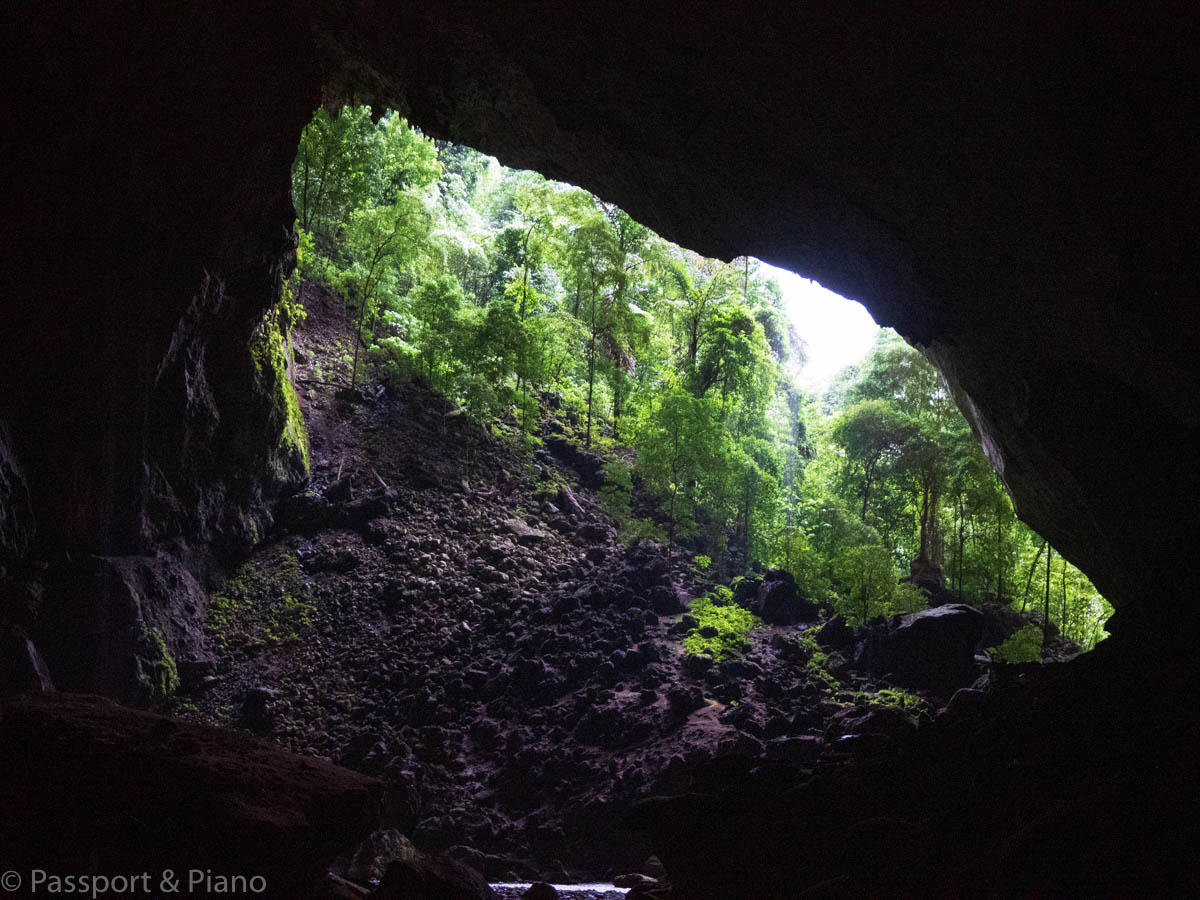
Amid this magnificent cave, there’s a large roof hole that lets in sunlight. It’s not sure how the garden formed, but a wealth of green vegetation thrives here. The Garden of Eden is a circular valley that’s just over a 1km wide.
The valley is covered in lush tropical rainforest and surrounded by tall limestone walls. For the more adventurous, you can book a walk through the Garden of Eden.
Another interesting feature of the Deer Cave is the entrance. It’s unique in that the rock has been naturally eroded and resembles a silhouette of Abraham Lincoln.
Deer Cave is home to millions of bats who belong to 12 species which is more than in any other cave in the world. They cling to the roof of the cave and from the walkways they look like a thick black carpet.
If you’re not to keen on bats, they’re nocturnal, and as the cave is so large, they’re a long way up.
Mulu Bat Observatory
After you leave the cave, most people wait at the bat observatory to watch the fantastic display of bats as they exit the cave every day around 4 pm.
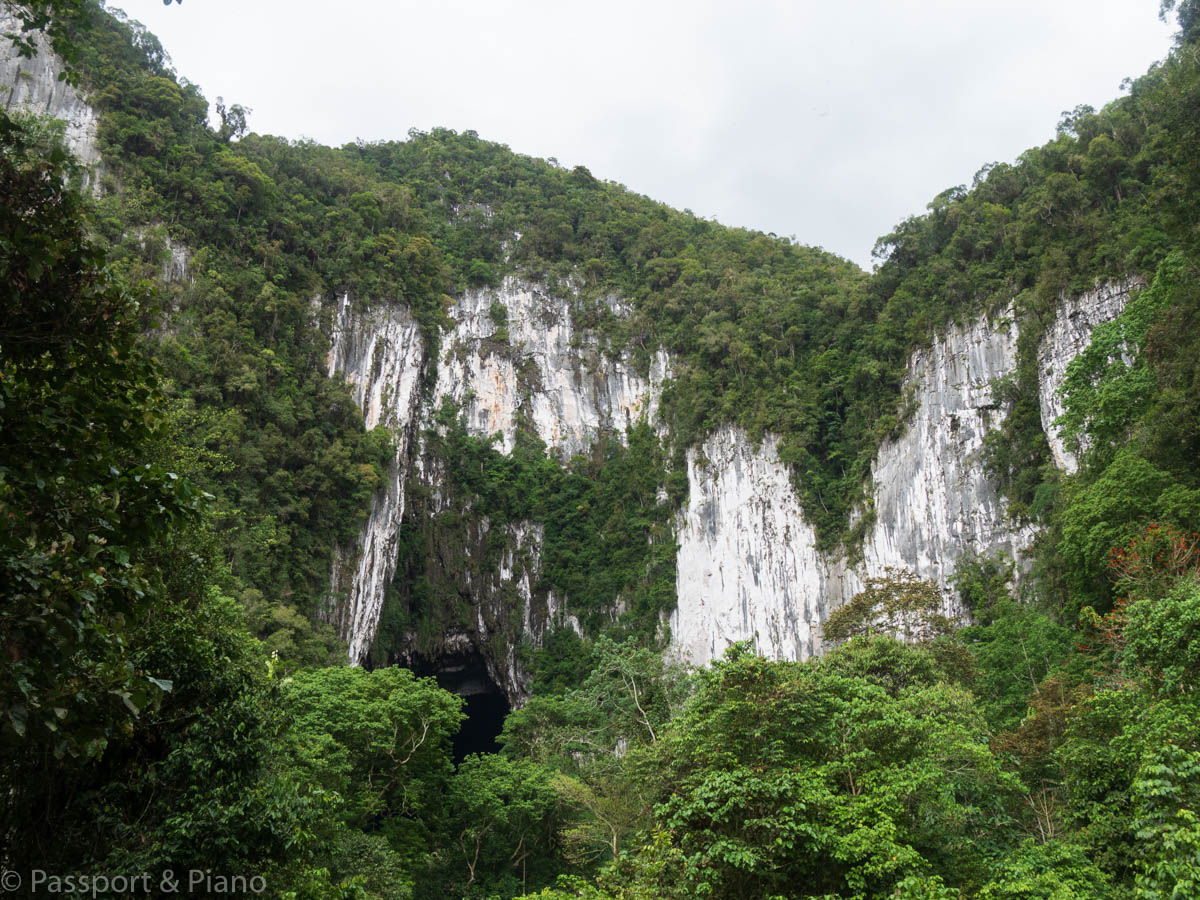
The spiralling patterns and swirling clouds are hard to describe, but its a sight like no other and well worth viewing. It’s also fascinating to watch the eagles swoop around the entrance to the cave as they wait for their dinner. It’s sad when they catch a bat, but I guess its all part of nature and the food chain.
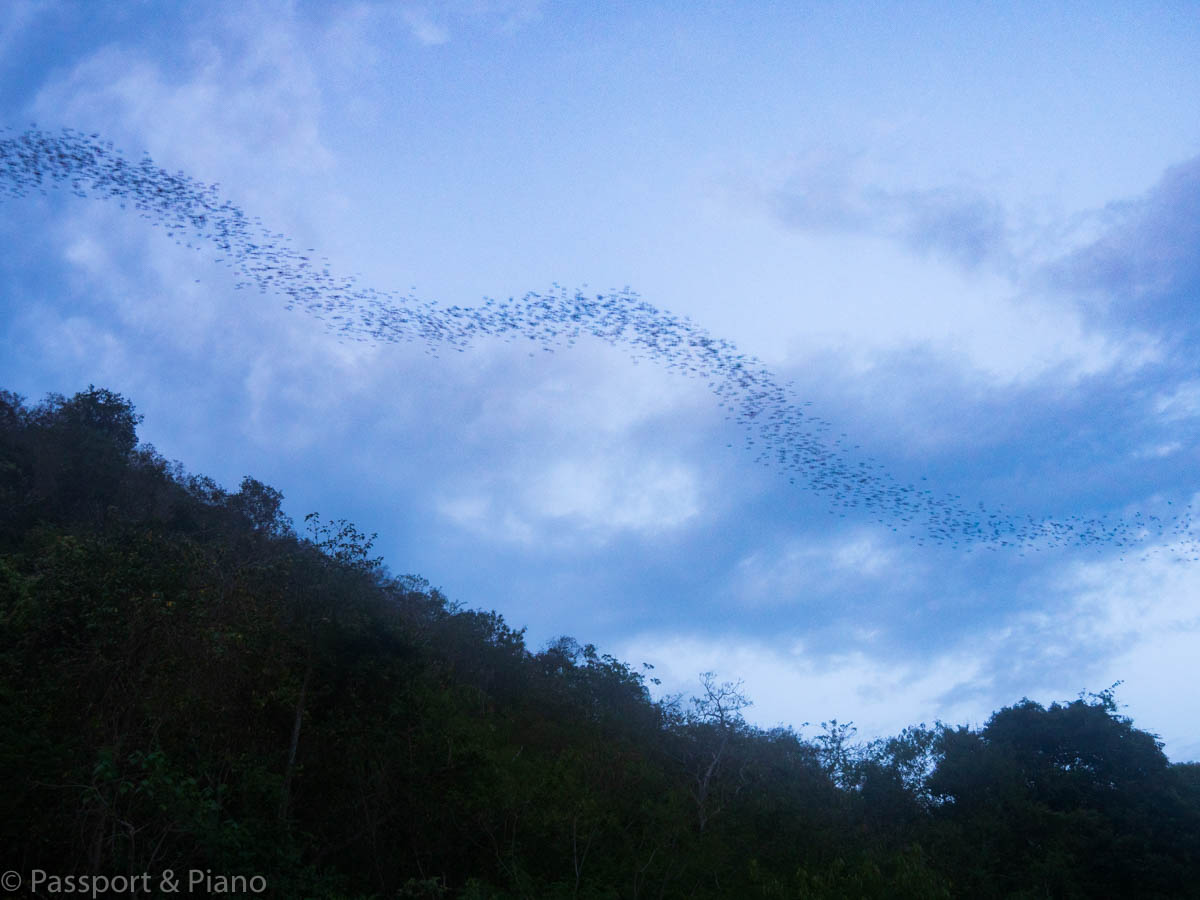
The bat observatory is a small outdoor theatre that has wooden benching to sit on while you await the bat exodus. There’s also a small kiosk that sells cold drinks and snacks.
If it’s raining the bats, don’t leave the cave so its not worth waiting. However, you can walk to the bat observatory on any evening without participating in a tour. Hence, if the weather is not in your favour after the Deer Cave tour, you can return on another evening when it’s dry.
Its believed that the bats from the Deer cave eat 30 tonnes of mosquitoes every night. As a result, you don’t need anywhere near as much mosquito repellent as you might think here in Mulu.
How to visit Deer Cave and the other Mulu National Park tours
The Deer Mulu cave tour can be booked through the Mulu National Park Headquarters. In peak season its best to book in advance which you can do via email or on their website. Payment for all tours is made on arrival and has to made in cash.
You can read more about booking a Mulu trip further down the page.
Lang Cave
The Lang Cave is the smallest show cave, and the visit is combined with the Deer cave tour. Inside the cave, the stalactites and stalagmites are stunningly beautiful.
The white limestone glistens under the torchlight, its an awe-inspiring sight. There are also magnificent helictites which seem to defy all laws of gravity.
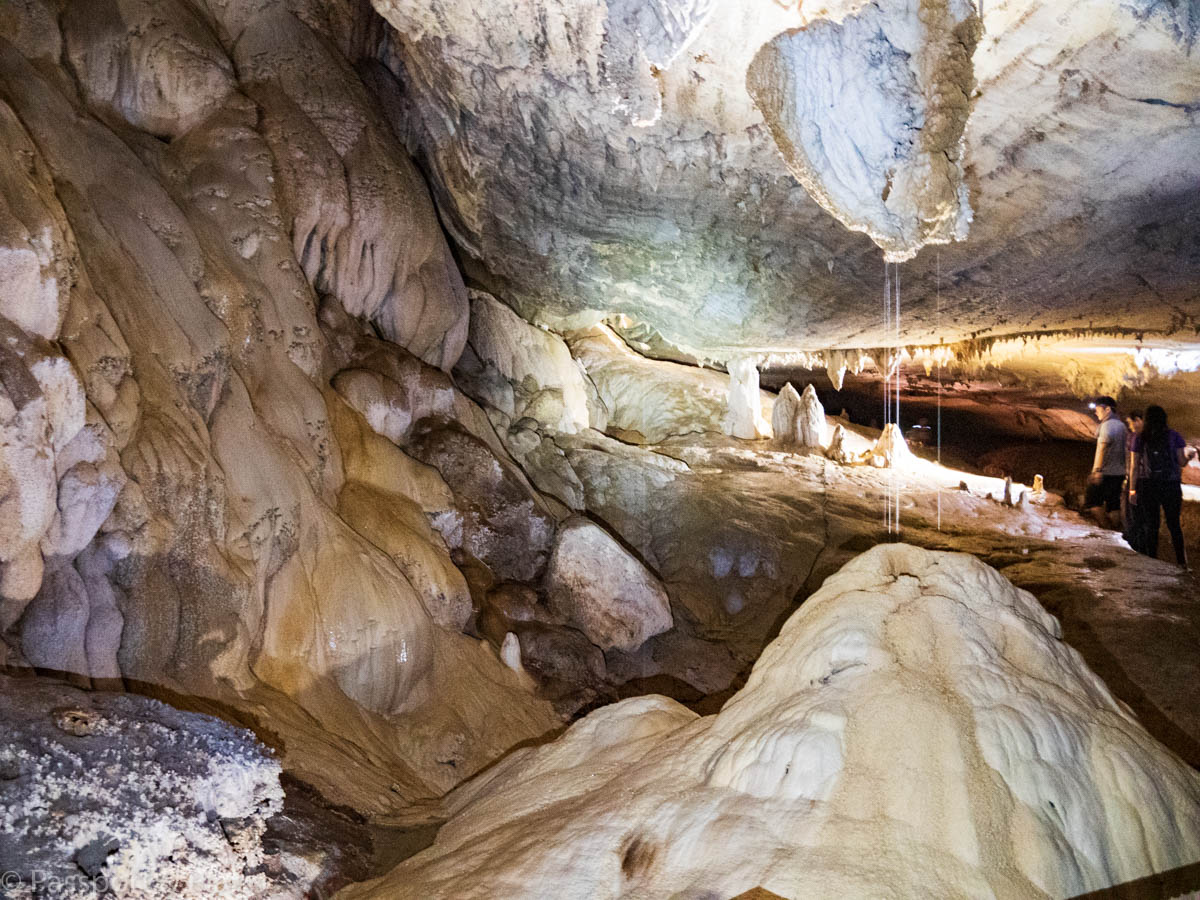
As Lang Cave is much smaller than the other show caves, you can get much closer to the ornate and beautifully carved limestone.
In parts of the cave, you can see glistening strings of what looks like lametta, but they are cave worms. They are incredibly delicate and translucent, but when the light shines on them, they glisten.
Clearwater Cave and Cave of the Winds Tour
This Mulu tour begins with a long boat ride along the Melinau River. The ride itself is a fantastic trip and allows you to see the rainforest from a different perspective. You pass locals along the way going about their daily business, fishing in the river or washing clothes.

The boat makes a stop at the Batu Bungan Market, which is a tourist trap but at least you’re not hassled to purchase anything. The market is part of a small Mulu village which you can also walk around.
The local Penan people sell their handmade gifts and its one of the few ways that they can make money. On sale are woven baskets, jewellery and blowpipes and you can watch the women at work.
It’s only a brief stop and you’ll either love it or hate it, but don’t let it put you off this tour as the caves are what you come to see.
Cave of Winds
A short distance further along the river is the entrance to the cave of winds. There’s a narrow boardwalk to cross, and a few steps lead to the opening.
The wind cave Mulu is so-called because of the cool breezes that you can feel in the narrower parts of the cave. Its part of the Clearwater system and like other Mulu caves the rock formations, helictites and rock corals are spectacular.
The main attraction is the king’s chamber.
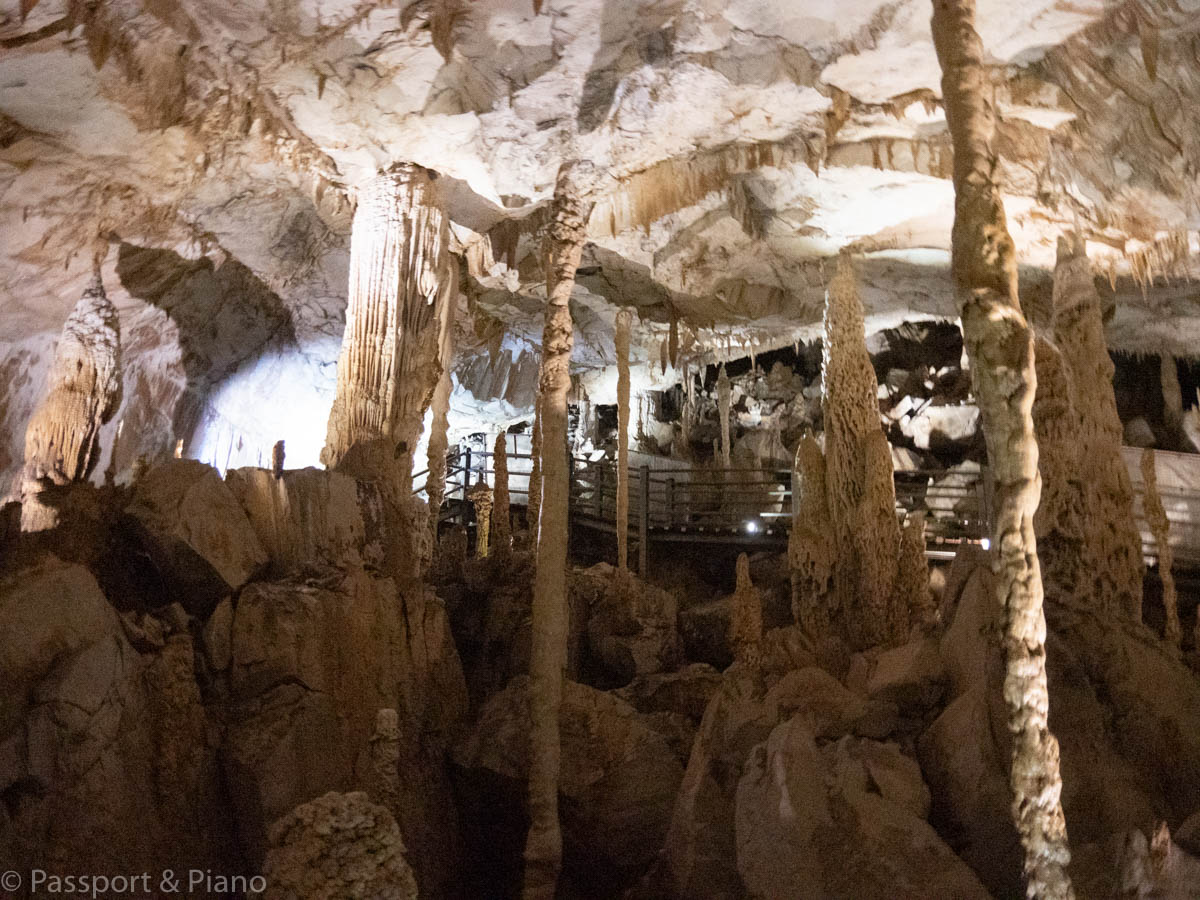
Here are some of the best examples of stalactites and stalagmites of all the caves. The intricate patterns of the limestone are illuminated so you can appreciate them.
The chamber takes its name from the formations which are said to resemble a king with his soldiers.
As you follow the walkways around the caves, the features and limestone columns are awe-inspiring. This cave is undoubtedly one of the worlds hidden gems.
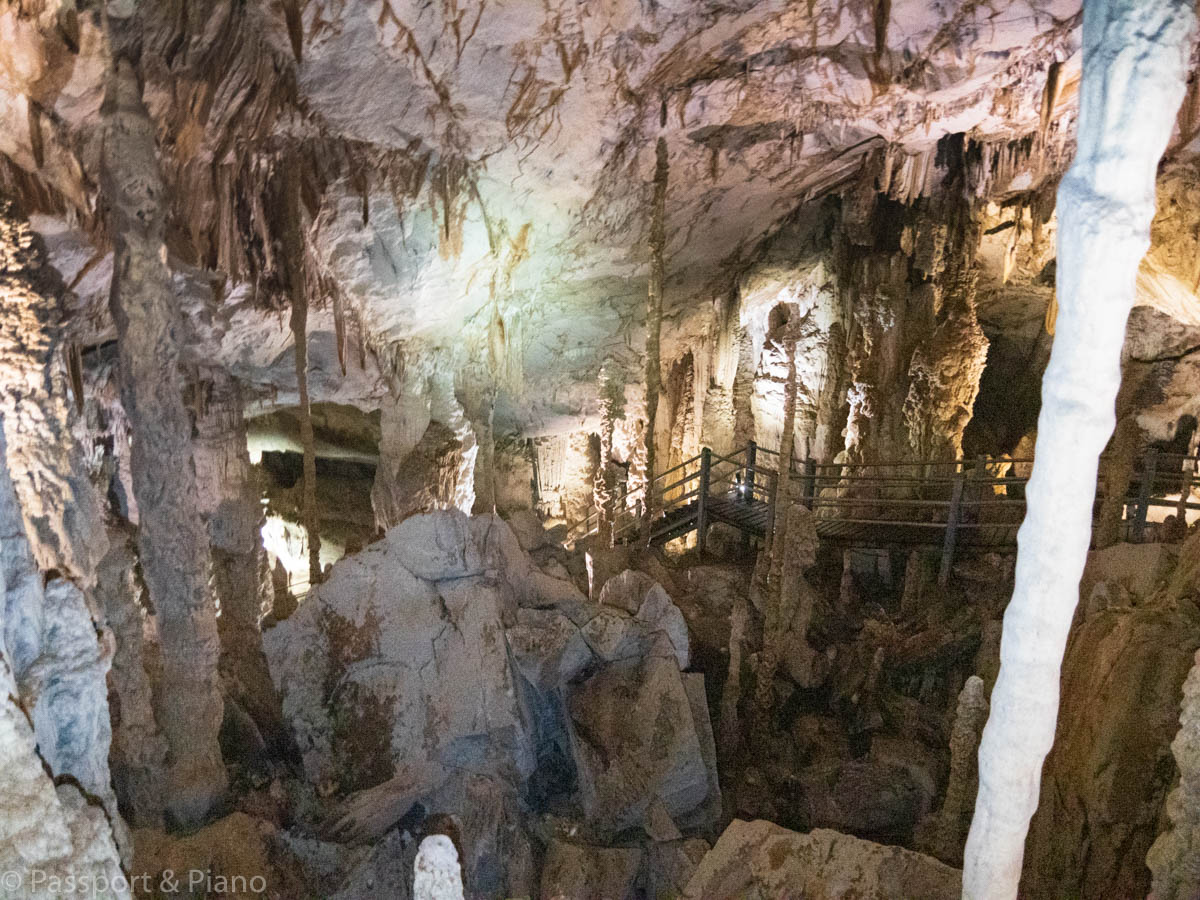
Another unique feature is the sky garden in the middle of the cave. Like the Deer cave, the cave has a roof hole which has allowed plants to thrive on the rock face. As you look up, you can also see the swiftlets swooping around as they enter and exit the cave.
These small birds build their nests inside the Mulu caves, and if you take the Fast Lane tour, you can see them much closer.
Clearwater Cave Mulu
Further along, the river is the Clearwater Cave, but first, there are 200 steps to climb.
You can take your time, and the guides don’t rush you if you need to rest. At the top, there’s a seating area so you can enjoy the view over the river while you get your breath back.
The entrance is surrounded by indigenous plants that grow nowhere else in the world apart from Clearwater Cave.
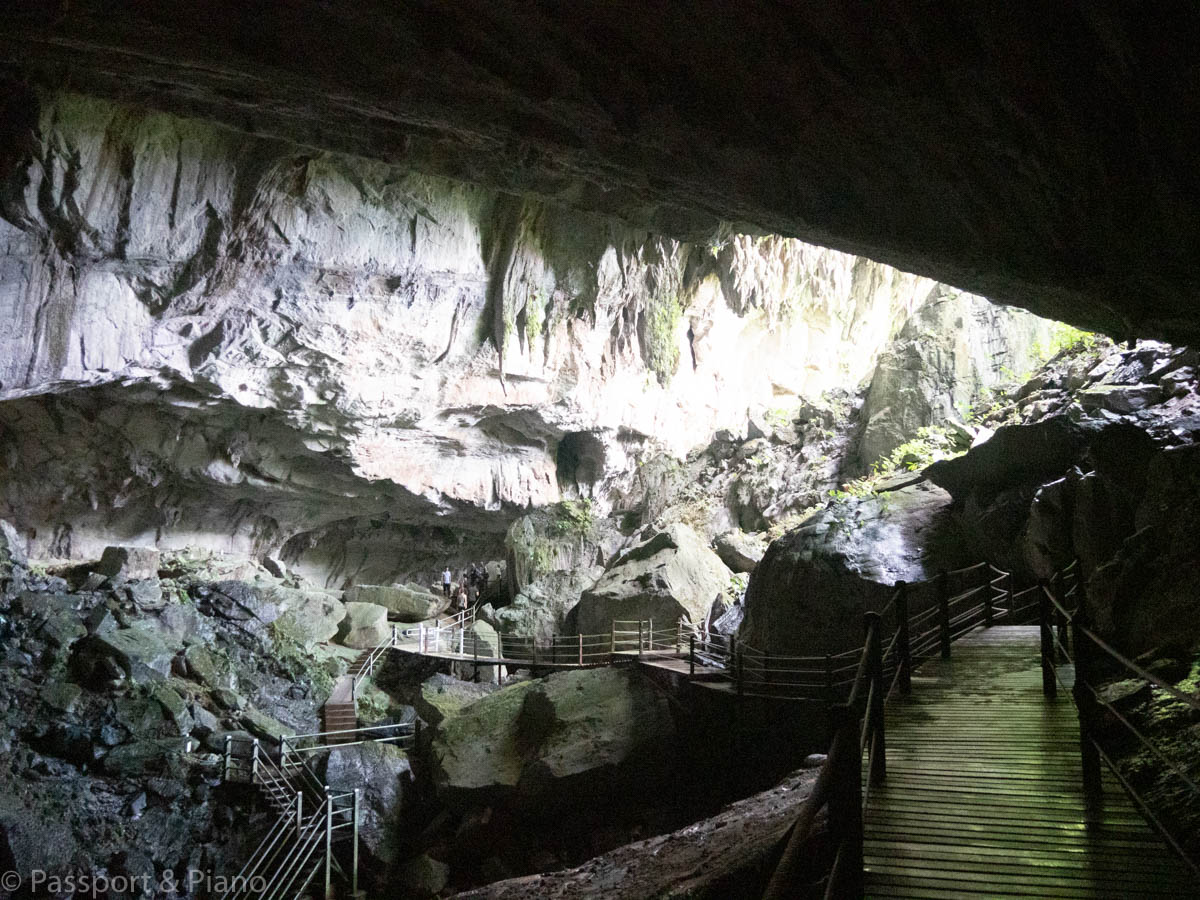
This cave is massive, and professional cavers are still discovering passages today. Its thought to be 220km in length although the section open to visitors is much smaller than that.
However, you can explore some of the more challenging passages if you take one of the adventure caving tours.
Unlike the other show caves, one of the main features of this cave is the subterranean river that runs through the centre. The river is well lit, and the walkways which have delightful bridges make this an accessible cave to explore.
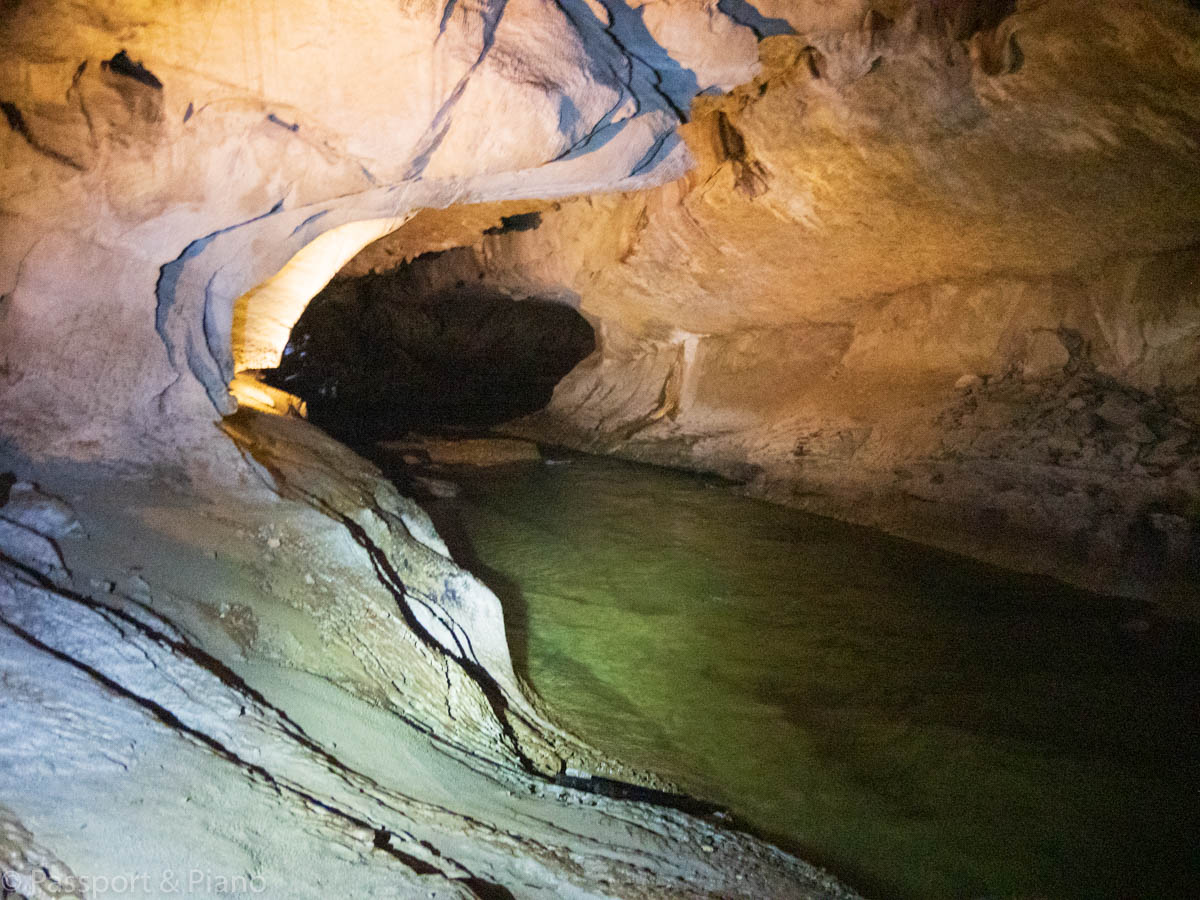
On the banks of the river, you can see the different layers of straiter that have built up over millions of years.
The way the river has gorged out the rock is incredible, and there are some beautiful curves to admire. Like the other caves, there’s a small garden where daylight has allowed vegetation to grow and some rock formations although these are less significant than in other caves.
One of the most impressive structures is the grey pinnacles.
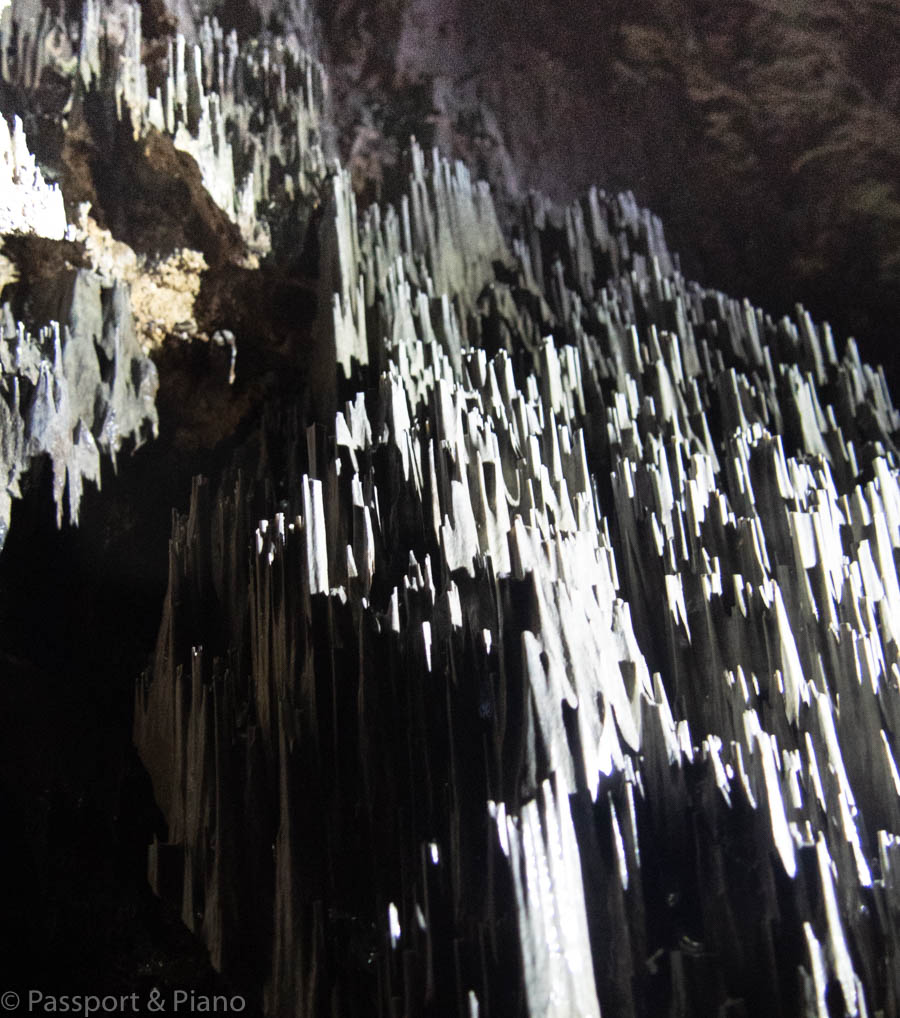
Their jagged edge is most unusual and looks like a rock but its a type of bacteria.
Lady Cave
Lady cave is a small part of the clearwater system that you can also visit. It only takes 15 minutes to walk around, and although it’s much less impressive than the other caves, the shadow that forms the figure of a lady is worth a look.
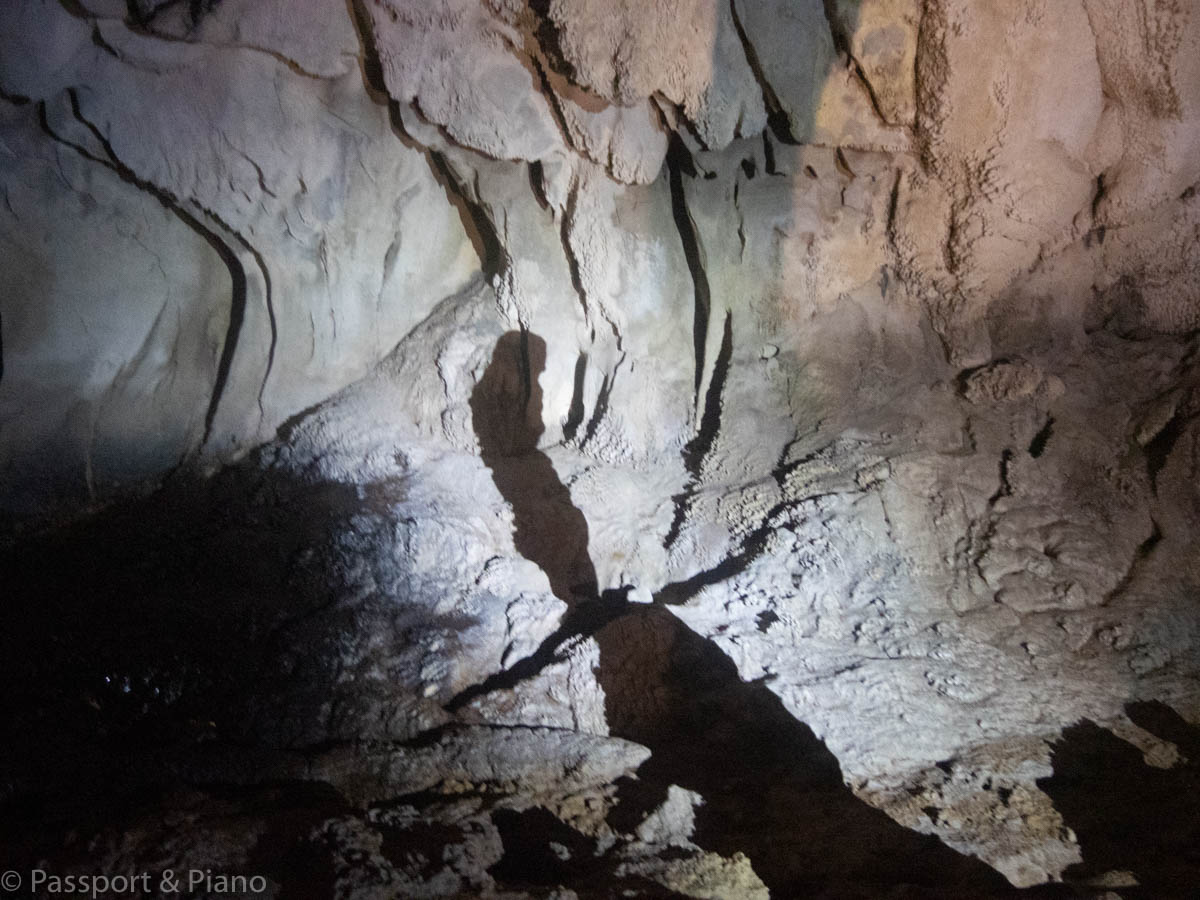
On leaving the cave, there’s the opportunity to swim in the natural lagoon that has crystal clear water which flows from the cave.
If you don’t fancy a swim, look out for the beautiful butterflies that hover around the picnic area.
Langang Cave Mulu
You can visit Langang cave on the Fast Lane Mulu Caves Tour. The trip begins with a short boat ride down the Melinau River followed by a 1km walk through the tropical rainforest.
Much of this tour is in darkness, and you’re encouraged to discover its features by yourself, although the guide points important things out along the way.
The cave has some of the best stalagmite and stalactite formations. The most impressive ones have lights, so you can see how magnificent they are.

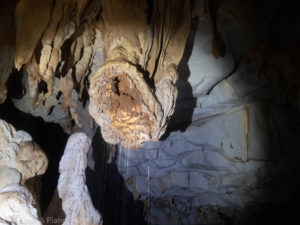
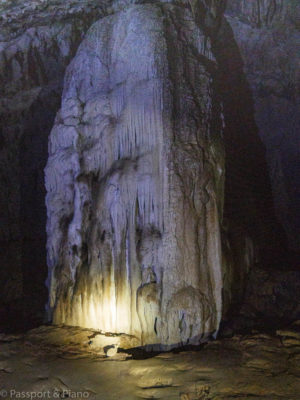 There’s plenty of wildlife inside the cave, and at times it was a little nerving not being able to see other than by torchlight.
There’s plenty of wildlife inside the cave, and at times it was a little nerving not being able to see other than by torchlight.
Starting on the floor in the small rock pools, you can see the white crabs which are blind and can only survive in the dark.
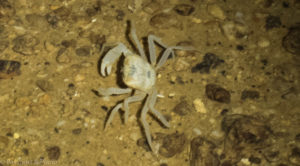
A little higher up the walls, you can spot the cave crickets and spiders. You may also catch a glimpse of the blue racer snakes, so take care when touching the handrails. The cave is also home to bats and swiftlets which are easier to see than in other Mulu caves as the ceiling is much lower.
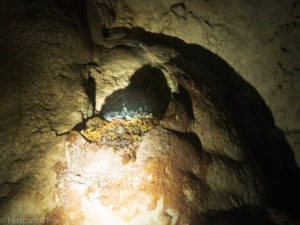
The nests of the swiftlets used to be collected by locals and sold for vast sums of money to restaurants. Bird nest soup is a rare delicacy that many Asians will pay a high price for in restaurants.
Thankfully the swiftlets’ nests in Mulu are now protected. Many of the hunters have now retrained as tour guides.
I’ve got to admit I didn’t enjoy this tour as much as others as I wasn’t keen on the birds and bats flying so close to me. However, the trip was a unique experience.
Adventure Caving
For the more adventurous you can take beginner and intermediate caving tours in Langang cave. The passages are not too narrow, but you do have to scramble over boulders on this 2 to 3-hour underground experience.
Racer Cave Mulu (intermediate level)
To participate in the adventure caves, you have to be over the age of 12 and be reasonably fit. Guided ropes assist you in climbing up and down the passageways, and you need a reasonable level of upper body strength to help you along the trail.
There are some fascinating insects and snakes to admire along the route and adrenaline seekers will enjoy the physical challenges.
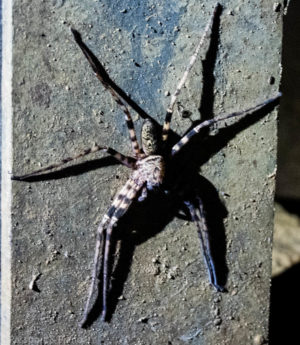
Many of the insects have odd-shaped bodies as they have adapted to life underground, and the racer snakes are beautiful in colour. The snakes are not dangerous as bats are there preferred option at mealtimes.
Clearwater Rival (intermediate)
Depending on the river levels you will have to wade, swim and climb on this adventure caving trip. It’s not for beginners, and the tour is weather dependent if you’re interested in this type of adventure, its best to contact the Mulu Sarawak National Park tour desk well in advance to plan your visit.
Clearwater Connection (advanced)
The clearwater connection tour is a more extended trip which takes 6 to 8 hours to complete depending upon your level of fitness.
The journey begins in the Cave of Winds on the wooden walkways used by the show cave visitors. However, you soon venture off into the wild and rugged passageways.
The route is 5 km long, and large boulders cover the terrain. You have to climb up and down muddy slopes, negotiating rocks along the way.
Particularly hazardous areas have ropes to assist you, and the guide carries additional lines in case they are required. The last section is through the river so participants must be able to swim, and the tour is dependent on the river levels.
If you are an avid adventure caver, you may also want to consider the Sarawak Chamber overnight at Camp 1 trip. This challenging tour involves some demanding steep climbs, and the highlight is spending the night deep in the rainforest.
How to book Adventure Caving at Mulu
Adventure caving tours should be planned well in advance as the availability of guides is limited, and if the water levels are too high, the trips are not possible. For more information on booking adventure caving tours, click here for an enquiry form.
To participate in advanced caving tours, you must be able to demonstrate one of the following.
1)You’re a current member of an internationally recognised speleological society or caving group
2)You can provide evidence of previous caving experience that describes at least a 5-hour expedition in a wild cave that has no lighting or pathways. The Mulu Park manager has to approve any written proof.
The information you provide should include which caves visited, the location and what the trip included, e.g., crawling in confined spaces, vertical rope work, swimming etc.
3) You have completed one of the intermediate caving tours at Mulu
Mulu Discovery Centre
The discovery centre is a great place to learn about the geology of the Mulu national park and all about caves and their formation. The information boards are well presented, and all the text is in English.
There are also some fabulous photographs of geologists and cavers who have spent time in the area discovering and studying the ongoing exploration of the Mulu cave network.
What to do in Mulu besides Caves
Guided Walks
In addition to the numerous free unguided trails that you can explore, five guided tours are possible.
The Mulu Canopy Sky Walk (2 hours duration)
The Canopy Skywalk is probably the most popular tour at Mulu and its advisable to book this excursion in advance of your arrival. There are six skywalks available each day, and group sizes are limited to 8 people.
The trip takes 2 hours and its not advisable for anyone who has a fear of heights.
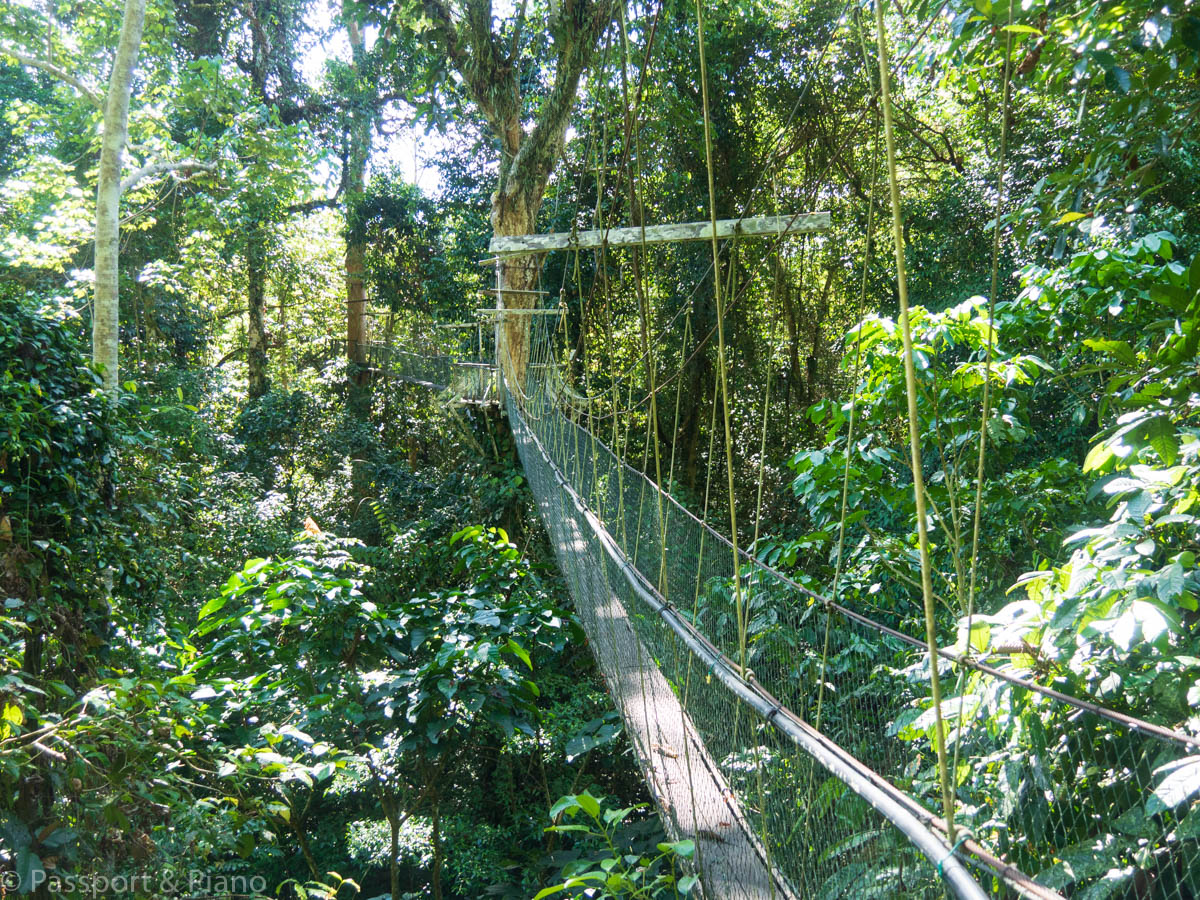
The canopy walk is the most extended tree-based walkway in the world and covers 480 metres. It’s a fantastic opportunity to take a closer look at the ferns and vines that grow above the dense forest floor beneath.
If you’re lucky, you can spot hornbills and monkeys along the way. The rope bridges wobble and sway as you cross them, and only two people are allowed on them at any one time.
The scenery is spectacular, and the mountains provide a stunning backdrop to the jungle oasis.
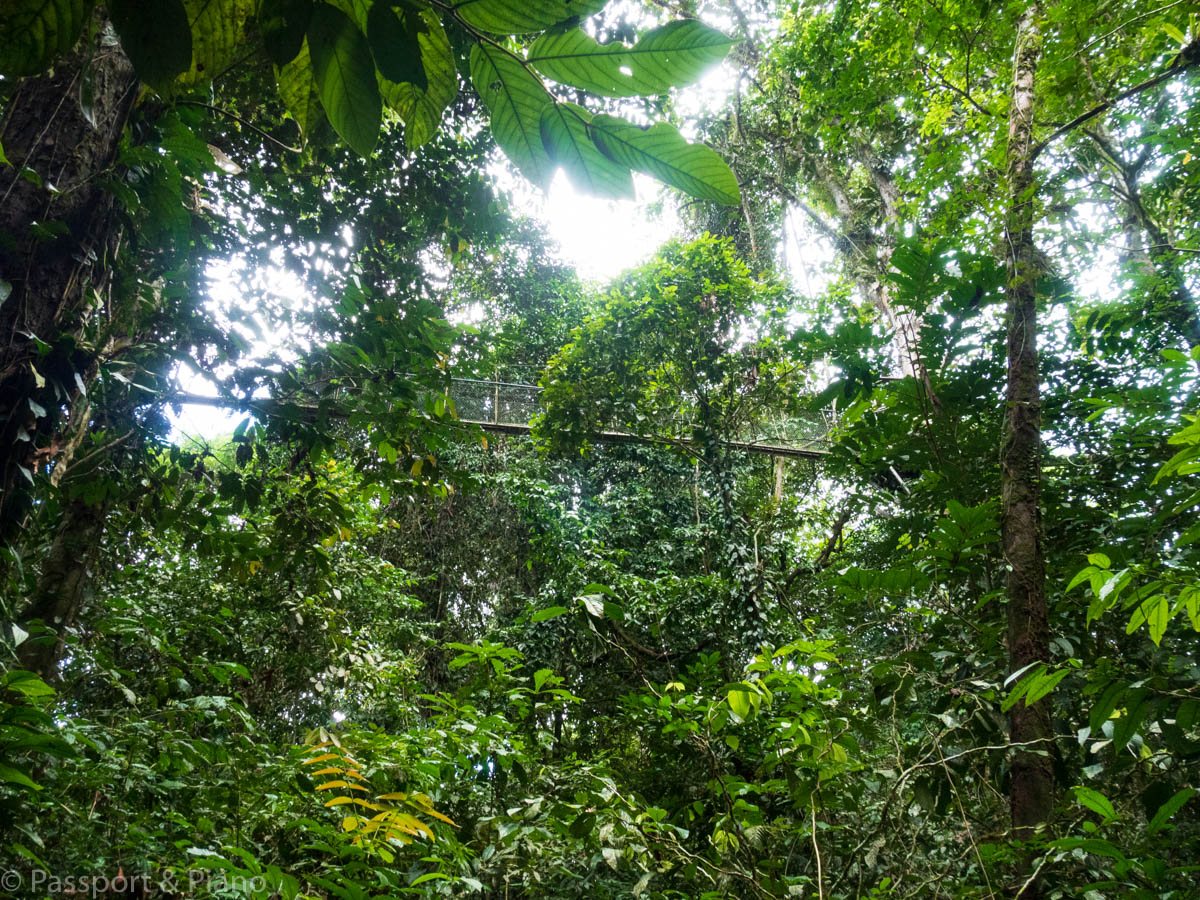
Along the trail, you will learn about the rainforest trees and insects while admiring the scenery.
The skywalk takes you across the river where there are more impressive vistas to admire.
If your a keen birdwatcher its best to make this trip early in the morning.
The Night Walk (1-2 hours duration)
The night walk is a must and like the sky canopy its essential to book in advance. The rainforest becomes like an orchestra of sound in the evening as many of its nocturnal inhabitants awaken.
Mulu has developed a rich habitat for thousands of species and if your quiet and follow the instructions of your guide there’s a multitude of insects, spiders and frogs to see.
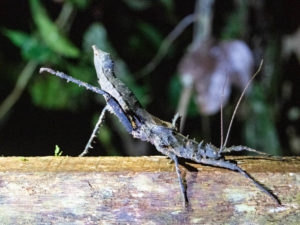
 The tour departs from the National park headquarters and takes one of the circular routes along the wooden walkways.
The tour departs from the National park headquarters and takes one of the circular routes along the wooden walkways.
If you were to take this walk without a guide, you’d be unlikely to spot anything. The expertise of the park staff is invaluable. They know which trees and plants to look at and they can spot stick insects that are camouflaged from a distance.
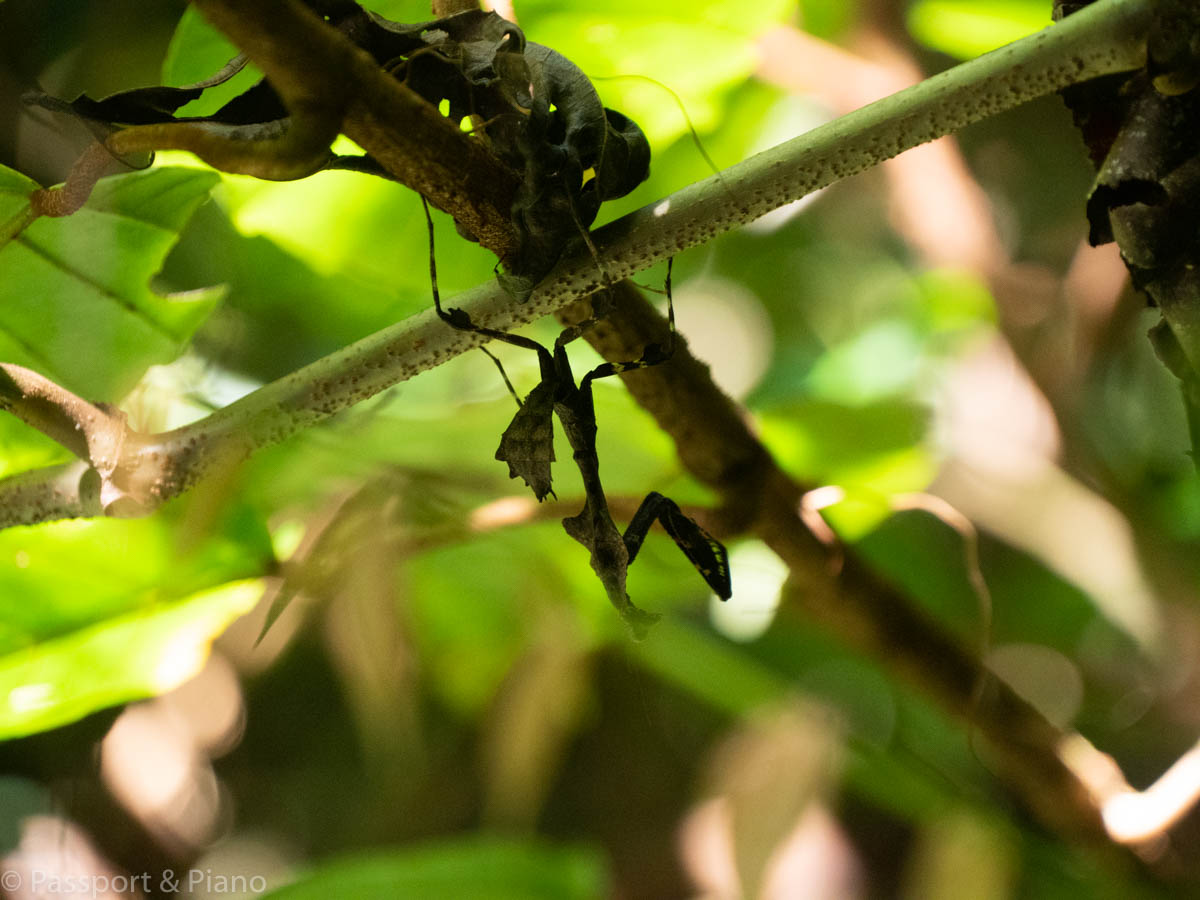
The frog species at Mulu are fascinating; some and tiny are quiet while others are much more vocal and noticeable.
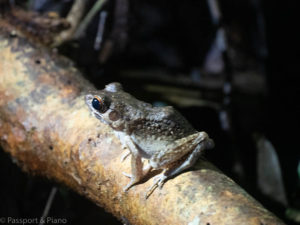
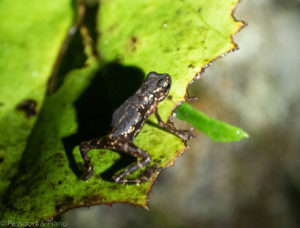
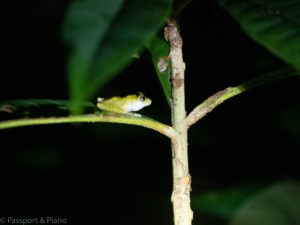
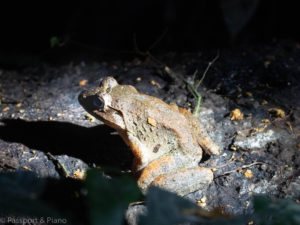
The insects are like no others I’ve seen before, and many of them are much larger than you can imagine.
Garden of Eden (full day)
The garden of Eden tour takes you into the enclosed valley that you can see from the deer cave. The trail is approximately 12km long and is an exciting trek that passes rock pools where you can take a swim.
To get there, you do require a reasonable level of fitness as you have to scramble over bat guano and slippery rocks. You also have to wade through water at specific points, and you will likely encounter leeches.
The guides will tell you what to do if a leach attaches to your skin but don’t just try and pull it off as this increases the risk of infection later.
This trip involves getting wet and dirty, so it’s not for everyone, but the scenery is stunning and makes the adventure worthwhile.
Make sure you read the packing list later in the post as the correct footwear is essential and it’s advisable to take a waterproof bag.
Mulu Pinnacles Hike (3 days)
The pinnacles Mulu are one of the highlights of the national park. The 45-metre high razor-sharp limestone spikes are an impressive sight, but the trek here is a challenging one.
A good level of fitness is required as the Mulu Pinnacles tour is a robust and challenging hike. That said it’s one of the parks most popular trails, so booking in advance is a must.
The tour requires a minimum of 3 participants, although you can pay more if there’s only two of you.
Day one
The first day begins with a longboat ride and a visit to the cave of winds and clearwater cave. From here its an hours ride up the river to Kuala Litut which is where the hike begins.
The first part of the trek is an easy 9km walk on a well-marked path which takes around 3 hours and brings you to Camp 5.
The sleeping arrangements are simple, and the camp only provides sleeping mats. You have to bring your bedding and a towel. These can be hired from the park’s headquarters if you don’t wish to bring your own.
Camp 5 has showers although there is only cold water and there are toilet facilities. The kitchen has gas and cooking utensils so you can prepare a meal from the food that you’ve brought with you.
Day two
Today is an early start, and after a hearty breakfast, the big adventure begins. Although the trail is only a couple of km to the pinnacles Mulu, a significant proportion is uphill.
The last section is particularly challenging as its virtually vertical, and you have a climb using ladders and ropes.
It depends on your fitness and the group’s overall fitness to how long it takes, but it will be anything between 3 to 5 hours.
At the top, one of nature’s most exquisite vistas await, and you can relish in the fact that relatively few people in the world have ever been here.

The pinnacles are unlike anything you will have seen before and its a genuinely awe-inspiring sight when you see them for the first time. Once you’ve explored the area the descent back to camp 5 is equally challenging, so you’ll be ready for a rest
Day 3
Another early start and a long walk back to Kuala Litut to catch the boat. You get back to the park headquarters around lunchtime, and if you’re like me, you’ll spend the rest of the day recuperating by the pool at the Mulu Marriott.
The Mulu Summit Walk ( 4 days)
The Mulu summit trek is physically demanding hike to almost 2400 metres above sea level. The trail starts at 27 m, so that’s a considerable uphill hike over a 24 km trail.
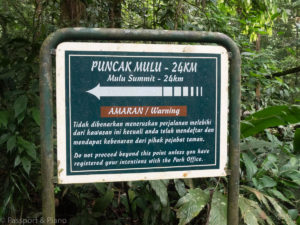
It takes a minimum of 4 days and three nights, but views from the summit are highly rewarding.
Along the way, you’ll have to conquer your fear of leeches and be prepared to sleep in the most basic of forest huts.
The scenery is spectacular and as you ascend the habitat changes from the montane forests, conifers and beautiful rhododendrons of the lower ground to the more sparse shrubland at the summit.
Porters can be hired to bring your equipment; otherwise, you will need to carry your food, water, sleeping bag and mat.
For those who would like a taster of the Mulu Summit Walk, you can experience one night in the rain forest at Camp 1. You will still need a guide as the crisscrossed route is not easy to navigate by yourself.
Mulu Headhunters Trail
For people who love hiking, this is a great way to either arrive or leave Mulu. Local tour operators organise the trek although you can do it without a guide on day 3 of the pinnacles tour instead of returning to the park headquarters.
The trail involves trekking through the jungle and travelling up the river and compared to other Mulu hikes its much less demanding. From Camp 5 you have to follow the trail to Kuala Terikan which takes approximately 4 and a half hours.
From here you have to take a boat to Medamit which is linked by road to Limbang. In either direction, transport needs to booked ahead of time, and you can arrange it through Borneo Touch Ecotour.
If you’re starting in Limbang and heading into Mulu, you need to remember to book a nights stay at camp 5. On route, you can either stay at the Ng. Metawai ranger station which is about 15 minutes from Kuala Terikan or you can stay at Rumah Bala Lesong which is a 3-4 hour boat ride upstream.
Unguided walks
There are six unguided walking trails that you can experience yourself within the Mulu National Park. All of the tracks are well signposted, so there’s no need to worry about getting lost although you have to register with the National Parks security office before departing.
The shortest walk is the Botanical Heritage Trail which is a 1.5km trail loop. You can see many of the exotic tropical rainforests plants along this trail and the path is easy to navigate.
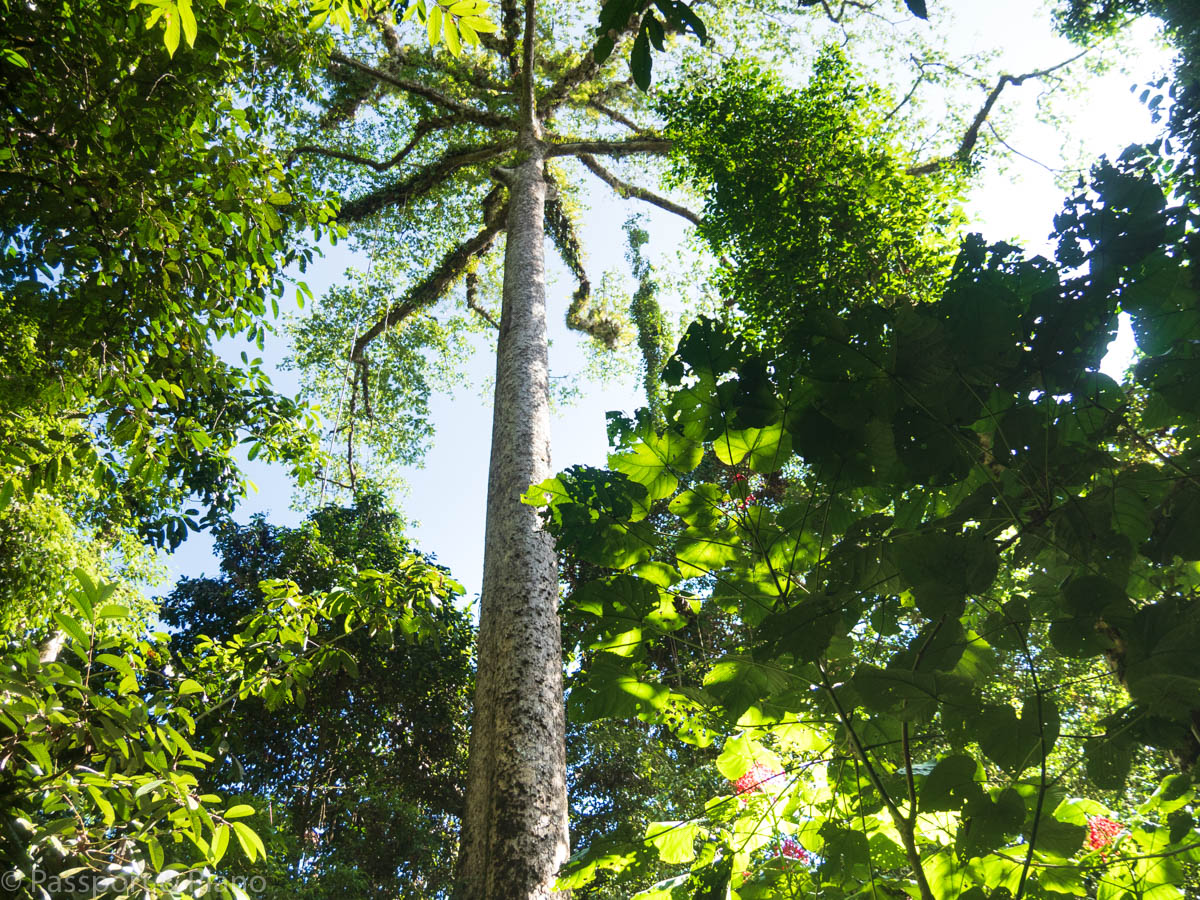
The Paku Waterfall trail is another popular option and takes around 2 to 3 hours to complete. You can swim at the waterfall before either retracing your steps or continuing along the Paku Valley Loop, which is an easy but a longer walk.

The section of path along the Melinau river is rather muddy and can be slippery. There are a few small streams to cross, and water levels can change quickly.
If your heading along this trail you have to inform the security office before you depart so they’ll no to come looking for you if anything happens.
Other walks include the Long Langsat Riverwalk and the Kenyalang loop. Along all the trails you can expect to see birds, butterflies and fantastic rainforest fauna.
Fewer tourists visit the unguided walks, so if you’re a quiet and tranquil moment to yourself in the jungle, they offer the perfect opportunity.
The Tree Top Tower
If you’re a birdwatching enthusiast, the treetop tower is the perfect place to spend a relaxing few hours. The treetop tower is a 30-metre high bird hide and its best visited in the early hours of the morning or the early evening.
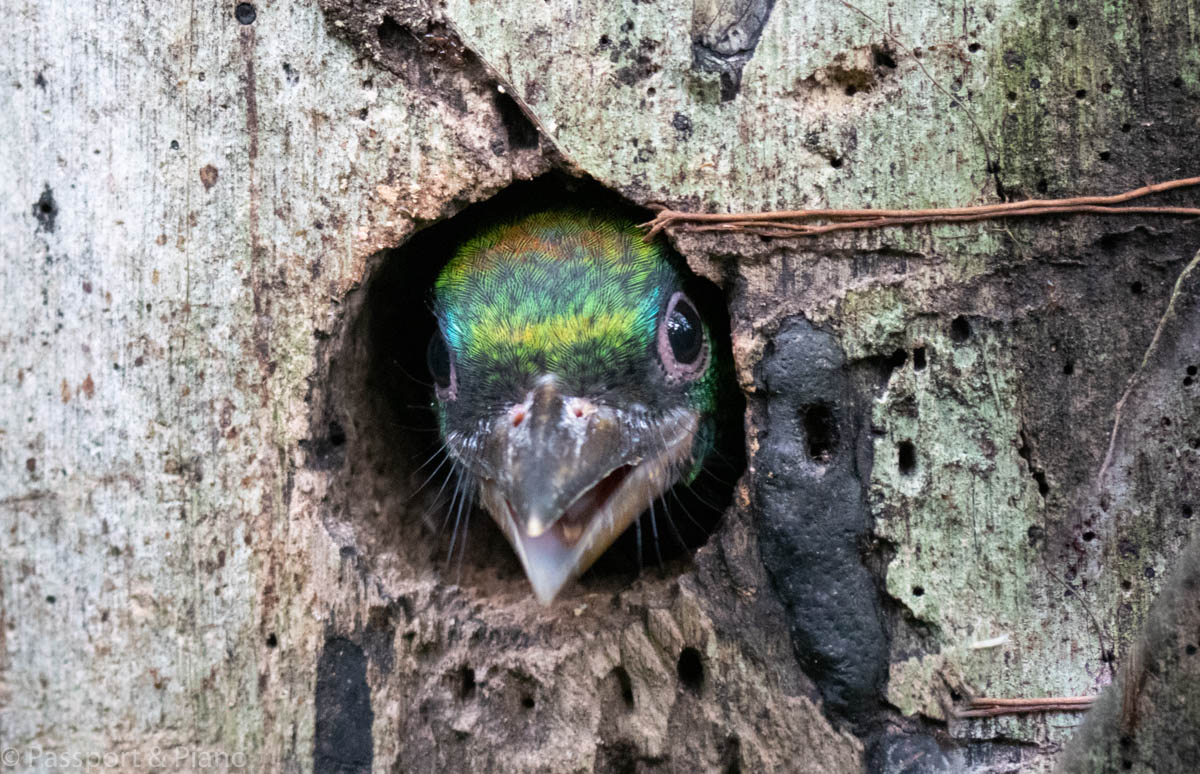
You have to pick up the key from security before walking to the treetop tower. It’s along the boardwalks in the direction of the deer cave, about 500m from the park’s headquarters.
I was fortunate enough to see a baby woodpecker while I was there. However, I was never quite quick enough with the lens to get a sharp image of the mother when she returned with food.
Plan your Mulu Malaysia trip
In this section, you’ll find all the information you need to plan a fantastic trip to Mulu.
Where is Mulu?
Mulu is in a remote area of the Miri Division of Sarawak. The Gunung Mulu National Park covers an area of 85,671 hectares and aside from the tropical rainforest Gunung Mulu (2377m high sandstone Pinnacle) dominates the magnificent landscape.
When is the best time to visit Mulu Caves
You can visit Mulu at any time of year. The temperatures are reasonably consistent throughout the year, and as Mulu is a rainforest, there’s a good chance it will rain at some point during your stay.
The wettest months are October to January and May through till June.
The peak season is between July and September as its school holidays and during this time its best to book your accommodation and tours well in advance to avoid disappointment.
How to get to Mulu National Park?
Due to the remote location, a flight to Mulu is the quickest and cheapest way to get there. MAS Wings, a subsidiary of Malaysian Airways is the only carrier that operates flights to Mulu.
To/From Kuching Sarawak
MAS Wings operates one Kuching to Mulu flight per day, and the journey takes 1 hour and 35 minutes.
To/From Miri to Mulu
There are two flights by MAS Wings to from Miri to Mulu. One in the morning and one in the afternoon. Its a short flight lasting only 30 minutes and the route is a popular choice.
To/From Kota Kinabalu
There is one flight a day to Kota Kinabalu, and it takes just under one hour. However, it’s not always direct, on somedays the trip goes via Miri.
To/from Bandar Seri Begawan
Flights to and from Bandar Seri Begawan operate on Mondays, Wednesdays, Thursdays and Saturdays. Its a short trip with a journey time of around 30 minutes.
Getting from Mulu Airport to Mulu National Park
If you’re staying at the Mulu Marriott Resort, the hotel provides a free transfer as do some homestays. If your accommodation is in the national park itself, your best option is to walk as Mulu airport is only 1km away from the park entrance.
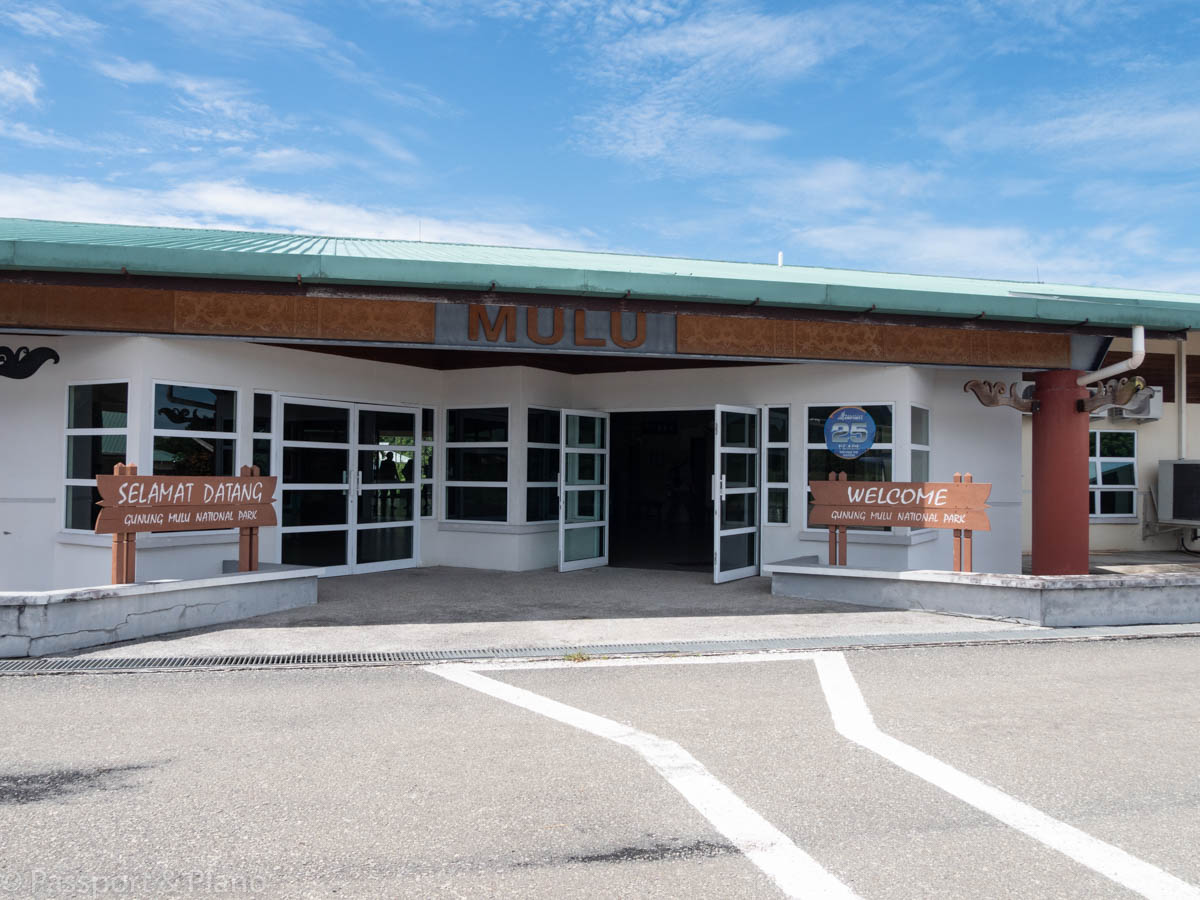
Travel to Mulu from Miri by Car
Miri to Mulu by road is theoretically possible although there is no proper track and conditions are often treacherous at best.
Gunung Mulu National Park Hotels
Mulu accommodation is limited to the Mulu national park accommodation or the luxury Mulu Marriott resort and spa.
Mulu Marriott
The former Royal Mulu resort is 5 minutes from the National Park entrance, and free bus service is available to and from the park through the day. You can read my full review of the Marriott Hotel at this link.
The hotel is by far the best place to stay in Mulu and its the only hotel. The lush oasis of the jungle that surrounds the Mulu Marriott and the wooden walkways that connect the communal buildings and the rooms enhance the spectacular scenery.
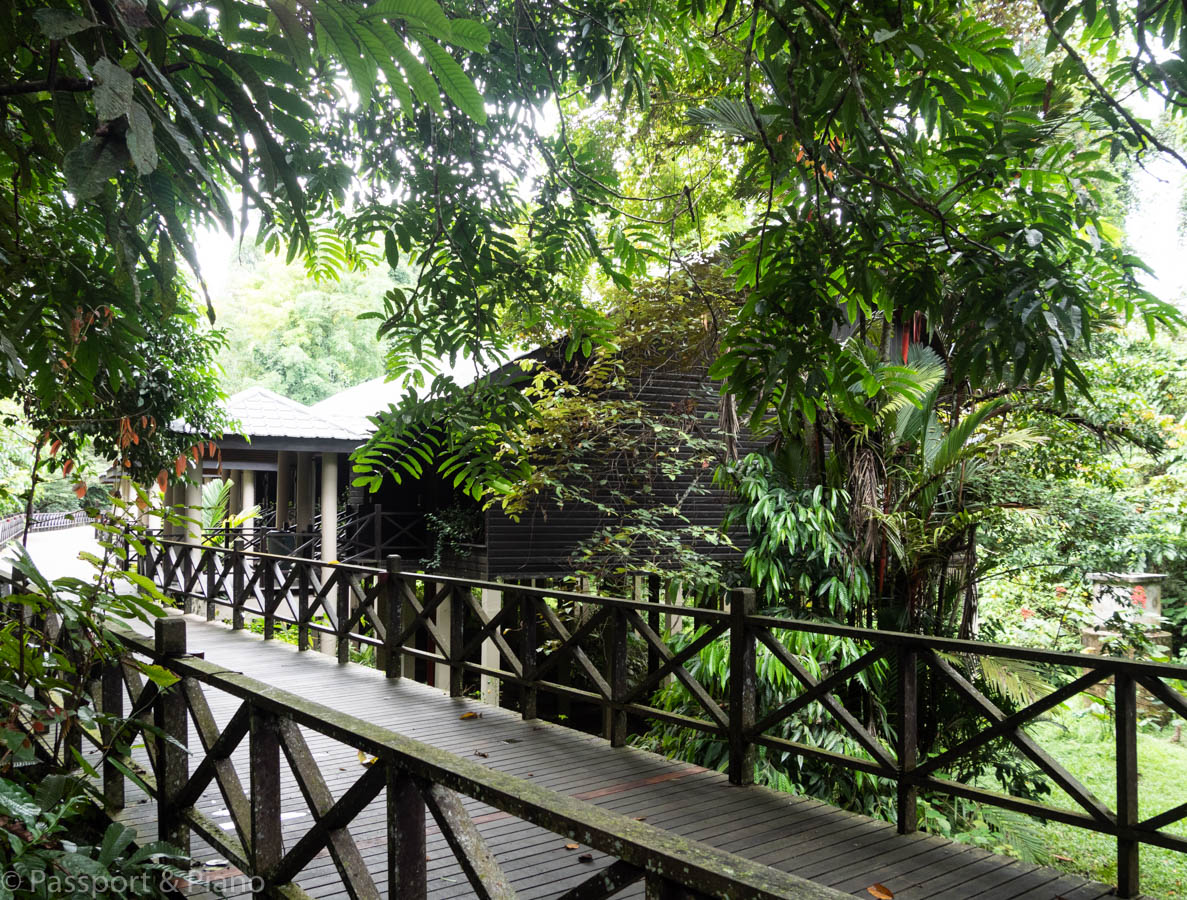
The facilities are high end, with spacious rooms, luxury bathroom suites, a restaurant, a swimming pool and a gym for guests to enjoy after a long day in the national park.
The buffet breakfast is excellent and there’s a wide variety of choice available. Options range from fresh fruit and healthy cereals to the vast selection of hot food, bread, cheeses and cold meats.
The Mulu Marriott also provides free wifi in the communal areas, which works better than the internet connection within the park.
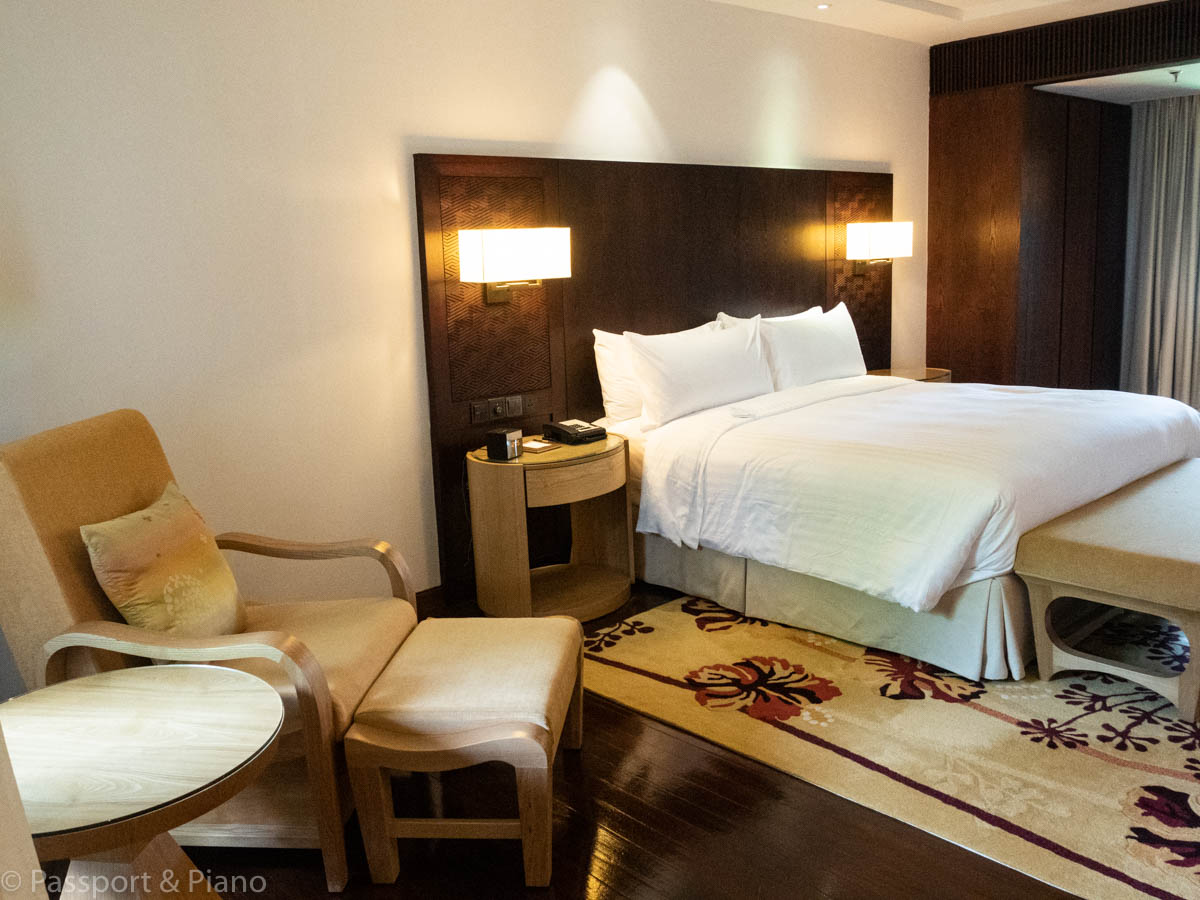
Rooms sell out fast in high season, so make sure you book well in advance. Booking the Marriott is straight forward and can be done quickly and safely through booking.com.
Mulu Park Accommodation
Within the national park, there is a choice of places to stay. Accommodation here is more budget-friendly than the Mulu Marriott although there are no extra facilities.
The deluxe garden bungalows can sleep, three people. The rooms are spacious and clean, with plenty of hot water provided in the bathrooms. You can also book the rainforest lodge which has a double bed and is very similar to the bungalows.

More budget-friendly options include the standard longhouses which have four single beds in each room or the hostel which has 14 beds and a shared bathroom.
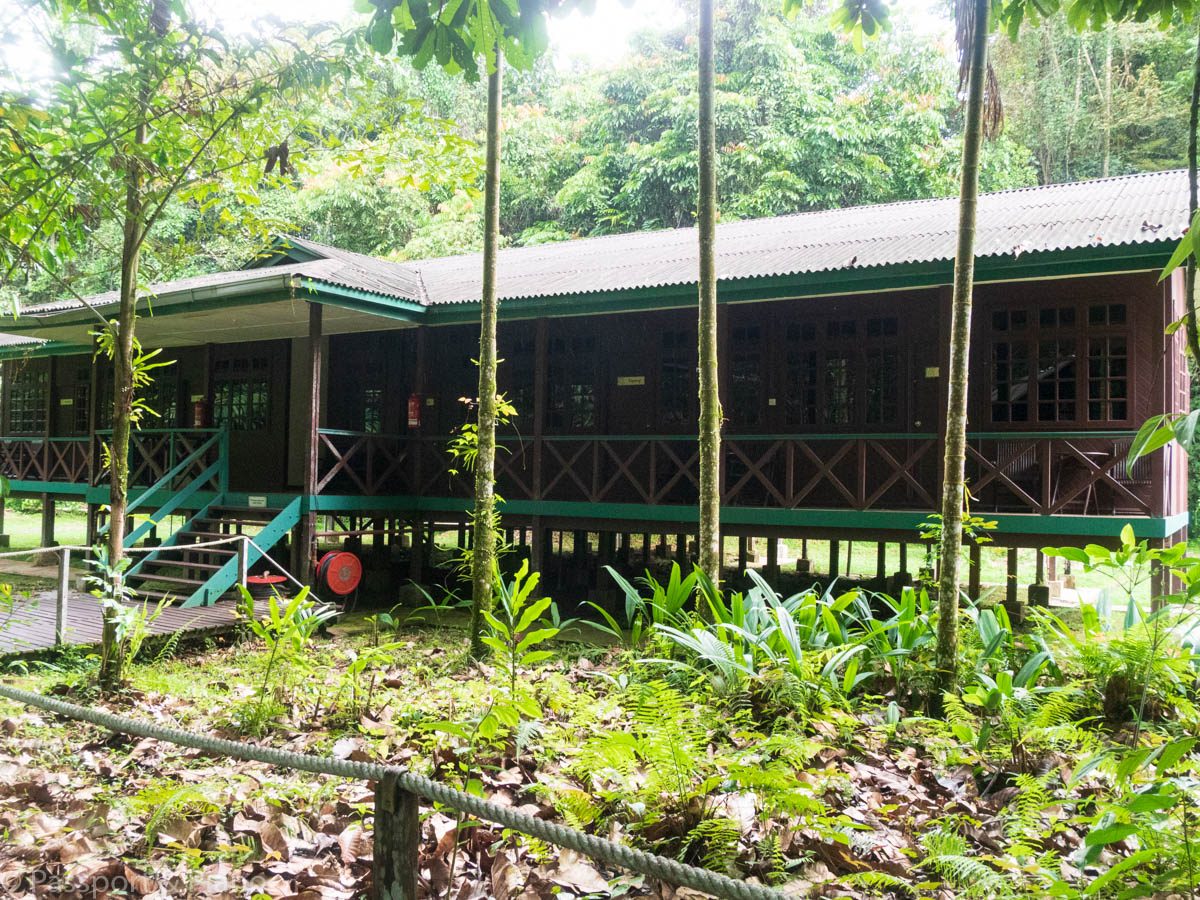
All accommodation at the national park includes a set breakfast at the Mulu cafe. You can only book through the National Park website, and you’ll have to transfer the deposit via credit card in advance of your stay.
The national park does respond quickly to emails, and if you have any questions or queries, they’ll answer them promptly. They’ll also send you information on how to transfer the deposit.
Remember to print off the receipt to take with you as evidence of how much you’ve paid.
Local Homestays
An alternative budget option to the Mulu national park chalet and longhouse is to stay at a homestay. There are several to close to the park, but I’d recommend the recently refurbished Mulu Diana homestay.
CLICK HERE FOR THE LATEST PRICES
The accommodation is basic, but it’s scrupulously clean, and Diana is a wonderful host.
Are you looking for a hotel in Kuching? Read my review here of the Hilton Kuching.
How to book Tours to Mulu Caves
If you are staying at the Mulu Marriott, you can arrange tours through their travel desk although prices are much higher than at the National Park. That said the Marriott has its own boat and you often get lunch provided.
All National Park tours can be reserved online through Mulu National Park website. You have to pay for the trips in cash on arrival at Mulu National Park.
National Park Pass
All visitors to the national park have to buy Mulu’s five day National Park pass. The tours do not include the pass, and you will not be able to access the park without it. How much does the National Park Mulu 5 day Pass cost?
| Price | Mulu National Park 5-day Pass -Prices are in Malaysian Ringgit |
|---|---|
| 30 | Foreign Adults |
| 10 | Foreign Children (age 6-18) Children 5 and under are free |
| 15 | Malaysian Adult |
| 7 | Malaysian senior over the age of 60 |
| 5 | Malaysian Children (age 6-18) Children 5 and under are free |
The pass is only available for five days, but you can buy a second one if you are staying longer. If you are visiting for less than five days, you still have to buy the pass.
Where to Eat in Mulu
Mulu Cafe
The Mulu cafe next to the park headquarters serves excellent food from breakfast to evening meals. It’s open from 7.30am to 8 pm, and meals are reasonably priced. There’s a varied menu with a good selection of vegetarian food.
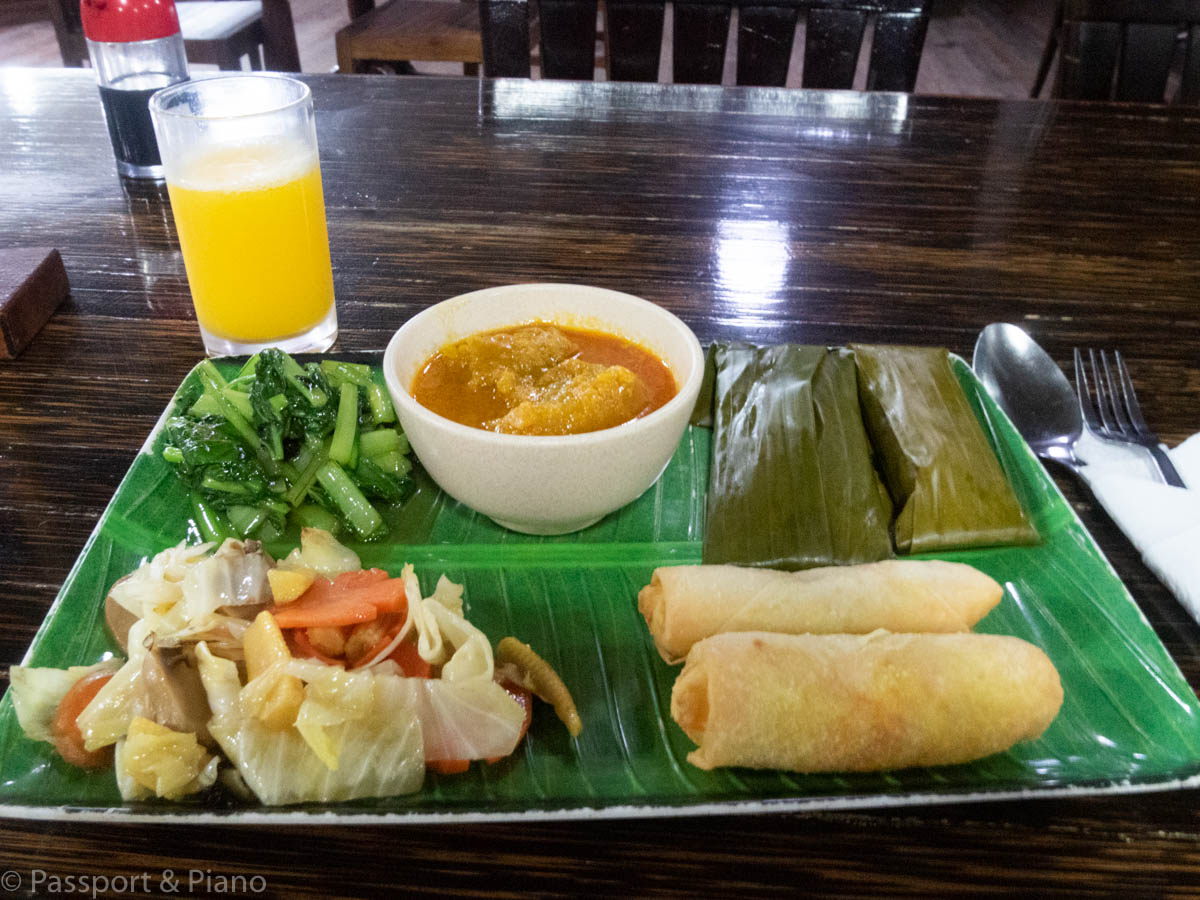
Options include local dishes such as Mulu Laska, Indian curries and western choices.
Good Luck Cave’fe Mulu
The good luck cafe is right outside the main gates of the national park and is open between 11.30am and 3 pm and 5 pm to midnight. Dishes include the usual Malay style curries served with noodles or fried rice.
Mulu Marriott
The Mulu Marriott has a la carte restaurant with a wide selection of dishes available although vegetarian choices are limited. Prices are considerably more expensive here, but the food is of high quality, and there’s a good ambience in the restaurant.
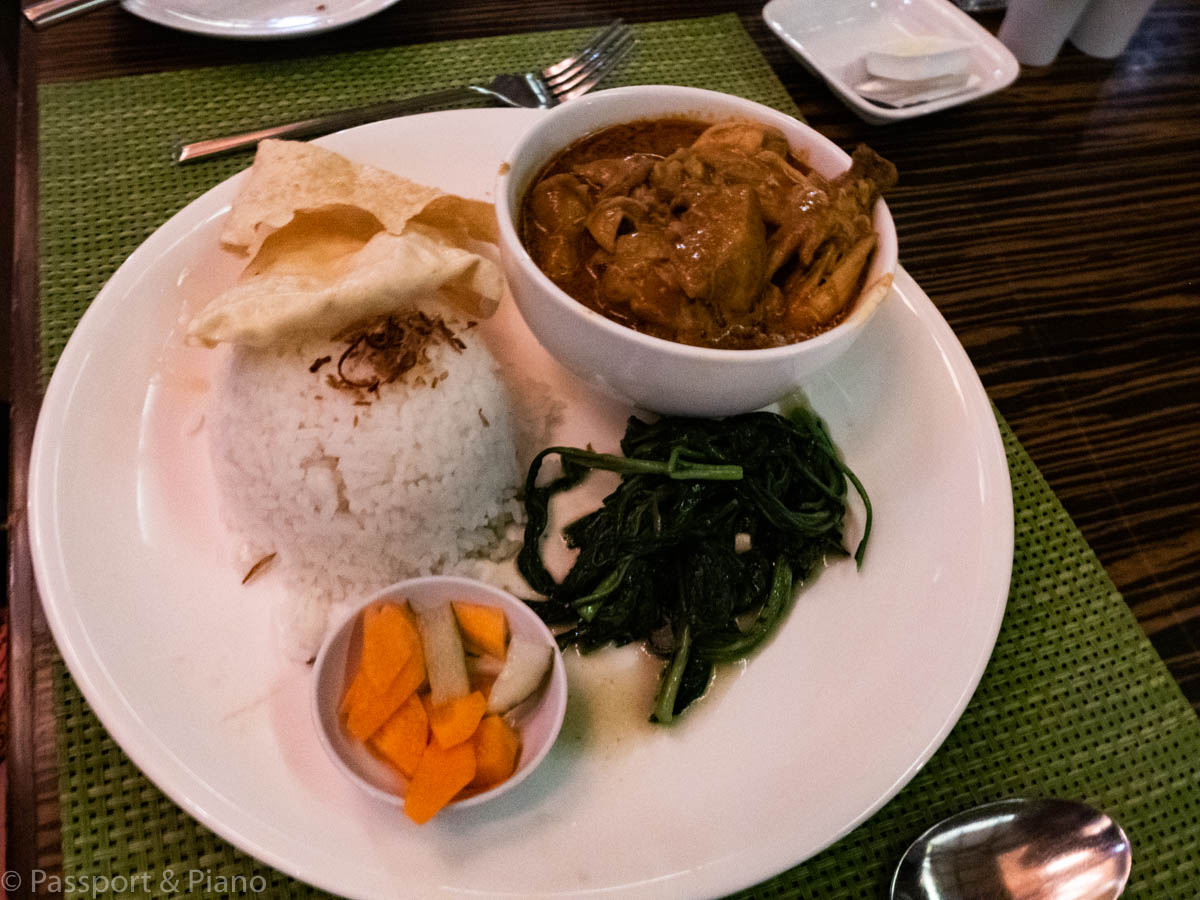
Cafe Tenguloh
Just across the bridge from the Mulu Marriott is the Cafe Tenguloh its open till 11 pm and serves a range of local dishes including some vegetarian options. The food and beer are cheap, although the food is nothing special.
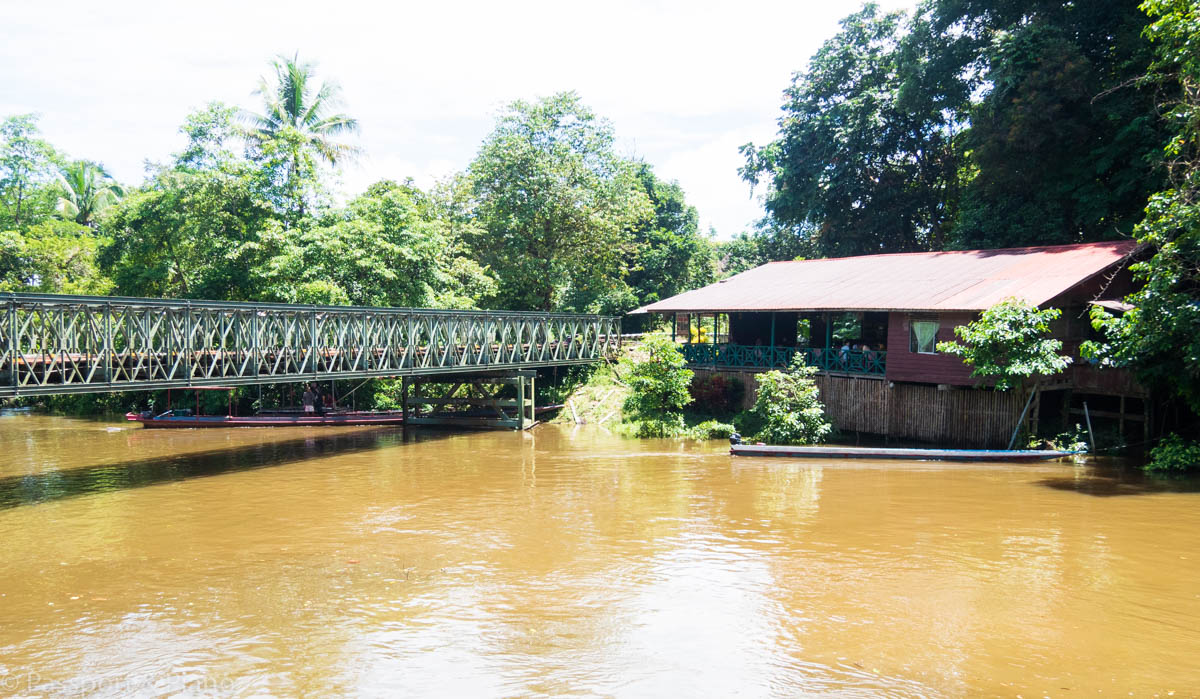
Supermarkets
The Mulu Gallery shop inside the park sells a range of snacks and soft drinks as well as souvenirs and essential items if you’ve forgotten to bring something. Prices are expensive but its a captive market so what do you expect.
SG Pala Canteen Supermarket
There is a small local supermarket a few hundred metres up the road from the Mulu Marriott. If you need to purchase groceries for hikes such as the pinnacle tour, this is the place to come.
There’s not a vast selection, but you’ll be able to find enough to take with you for a couple of days.
Wifi
Wifi signal is limited throughout the whole of Mulu National Park. The best wifi is at the Mulu Marriott hotel, although it isn’t available in the rooms.
Access to the national park wifi costs 5 ringgit for 24 hours; however, the signal isn’t reliable as it depends solely on satellite reception and the right weather conditions.
It’s best to switch off during your stay in Mulu and appreciate the natural jungle surrounds as opposed to getting frustrated by trying to connect to mobile devices.
Mulu Caves Package Tour
If you would like to visit Mulu caves but would prefer not to organise everything yourself, don’t worry as there is a good range of Mulu cave package tours available. Below I’ve listed the ones you can book online through major companies so check them out.
3-Day/ 2 Night Adventure in Mulu National Park (Tripadvisor)
✅ A choice of accommodation ❌ Flights
✅ Deer and Lang Cave
✅ Clearwater Cave and Cave of Winds
✅ Airport transfers
Mulu Caves Tour 4D3N & Pinnacles Hiking
✅ Three nights of accommodation
✅ Deer and Lang Cave ❌ Flights
✅ Clearwater Cave and Cave of Winds
Mulu Pinnacles & Headhunter’s Trail 5-Day Eco Adventure
✅ Four nights accommodation
✅ Deer and Lang Cave ❌ Flights
✅ Clearwater Cave and Cave of Winds
✅ Headhunter Trail
Borneo Tour Packages which include Mulu National Park
Wild Sarawak
A 10 day adventure holiday with Intrepid Travel which incorporates Kuching, Bako National Park, Mulu and Kota Kinabalu.
The Mulu National park section of the tour includes the following.
✅ Flights and all transport
✅ Accommodation
✅ Deer and Lang Cave
✅ Clearwater Cave and Cave of Winds
✅ Headhunter Trail
✅ Free time if you want to book the Canopy Sky Walk (cost not included)
Best of Borneo
Whether you organise a package tour or arrange your trip to Mulu independently you need to ensure that you pack the right the equipment. The next section lists the most essential things to pack but if you’re doing any of the longer trails you may want to bring some additional camping gear.
What to Pack for Mulu National Park
Raincoat or Rain Jacket
As Mulu is a rainforest, there’s a good chance that it will rain. The weather changes constantly, and one minute it can be glorious sunshine, and from nowhere, the rain can appear. Being tropical the showers are often short, and the trees do provide some protection, but a raincoat is essential if you don’t want to get drenched.
I have a Columbia Arcadia Jacket which I can highly recommend. It has two large pockets and folds into one of its own pockets to store. The jacket drys out quickly and it’s lightweight so its perfect for long days in the park.
Columbia also makes a Columbia Men’s Watertight Jacket which is similar.
Torchlight
Even in the show caves, a torchlight is handy and the Mulu National Park advisors recommended you carry one. A head torch is the easiest way but the downside it easier to illuminate specific things with a handheld one.
Travel First Aid Kit
There are no chemists in Mulu and its easy to get a scratch or a cut in the rainforest. A travel first aid kit easily fits in your day bag and is essential to carry if you’re going on any longer treks or unguided walks.
Trekking shoes with rubber soles
Although the caves around the park are accessible by wooden walkways, these become slippery when it rains. The unguided trails and treks to the Garden of Eden or the Pinnacles are often muddy, so a pair of trekking shoes with rubber soles is recommended.
These Edgewater muck boots are ideal for visiting the Mulu Caves. Muckster also makes women’s Muck Boots which are waterproof, shock-absorbing and they have a breathable air mesh lining.
If you’re looking for a pair of hiking boots under $100, you can read my review on the best ones for women here and hiking boots for men under 100 here.
Insect repelling Hiking Pants
While the bats do keep the mosquito population low, Mulu is still a rainforest, and there’s a diverse range of insects that live here. The easiest way to avoid insect bites is to wear hiking clothes with insect shield material. There’s a range of insect-repelling garments including socks, mosquito repellents and Jackets available on Amazon.
Water bottle
You will need to carry water on all Mulu cave trips and along the hiking trails. Do your bit for the environment and take your own reusable water bottle.
If you’re short on space these collapsible ones are fantastic.
Dry Bag
Drying clothes in the rainforest is not always easy due to the humidity and frequent rain showers. No one wants to put wet clothes in a suitcase, so what do you do with them? A dry bag offers the perfect solution and they can easily double up as a waterproof day bag.
Camera
While a DSLR camera is a preferred choice, you’re unlikely to want to take your best camera on caving activities. The Olympus Tough TG5 camera is ideal for Mulu as its waterproof, dustproof, shockproof and built for tough outdoor action. It also allows you to shoot images in raw format which is ideal for the caves as to get the best photos you’ll need to do some editing.
For more information on tough waterproof cameras, read my reviews of underwater cameras at this link. Most compact underwater cameras are tough and are not just designed for underwater use.
Binoculars
Binoculars are not much use in the caves due to the lack of light, but if you’re going on any of the treks and trails a compact pair of binoculars will come in handy. Of course, if you’re a birdwatcher and planning on spending some time in the treetop tower, you may wish to take a pair of birdwatching binoculars.
Money
Lastly, there are no ATM’s in Mulu National Park, so you’ll need to bring enough cash for the duration of your stay.
Passport and Piano is a participant in the Amazon Services LLC Associates Program, an affiliate advertising program designed to provide a means for sites to earn advertising fees by advertising and linking to amazon.com, amazon.co.uk, amazon.ca. Amazon and the Amazon logo are trademarks of Amazon.com, Inc. or its affiliates.

